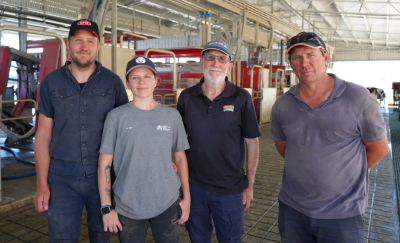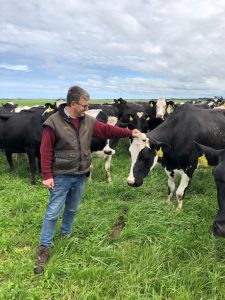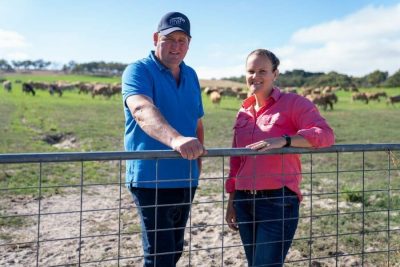
Showcasing Climate-Smart Innovations and practices at the 2025 SA Industry Climate Change Conference
SADA is proud to present three case studies at the 2025 SA Industry Climate Change Conference, South Australia's premier industry climate change event. This conference brings together keynote speakers, experts, industry leaders, and policymakers to discuss strategies for transitioning to net zero emissions, adapting to climate change impacts, and driving sustainable practices across all industry sectors in South Australia. James Mann, Hicks-Jacobs and Ben McHugh, showcase how the South Australian dairy industry is taking climate action by embracing climate-smart practices and innovation to create more sustainable, resilient, and profitable operations. These stories reflect our industry's commitment to sustainability through innovation, collaboration, and real-world impact.
Read their stories here!
Hicks-Jacobs: A lifetime of sustainable dairy farming

Summary:
Hicks-Jacobs Dairies is a forward-thinking partnership between two South Australian dairy families that combines innovative technologies, renewable energy, and sustainable practices to drive business growth while taking innovative action on climate change.
Full case study:
A decade-long partnership between two Mount Compass dairy families has driven strong business growth alongside innovative climate action. Hicks-Jacobs Dairies combines Misty Downs and Whispering Pines farms, managed by the Hicks and Jacobs families. Together, they manage just under 2,500 acres across South Australia’s Fleurieu Peninsula, adapting to climate change with practical, technology-driven solutions.
A key initiative has been investing in renewable energy. Solar and battery systems power both dairies, with Whispering Pines operating off-grid and exporting surplus energy during peak solar hours. A solar powered glacial system makes ice and cools milk, reducing electricity consumption. They’ve also installed heat recovery systems that reuse cooling energy to preheat water, improving efficiency. Variable speed drives on water pumps and motors adjust power use based on demand, further optimising energy consumption.
The introduction of robotics at Whispering Pines has transformed dairy operations. This innovation optimises milk production, improves cow health monitoring, and reduces human intervention, all while contributing to energy savings. Over the past 6.5 years, the dairies have used genomic testing to breed more efficient cows that produce higher milk solids per tonne of carbon emitted. One standout cow achieved a +1.99 kg CO₂e reduction below the national average, according to ECO2 indexes from STgen.
Water use is precise and efficient. Water is reused up to four times—for heat exchange, cleaning, and irrigation—minimising waste. Irrigation is solar-offset and targeted only where needed, while bore-fed troughs reduce reliance on dams and creeks. Pasture improvements, such as the introduction of perennial pastures like lucerne and phalaris, have improved drought resilience. These deeper-rooted plants draw more water, improve soil stability, and require fewer inputs than annual pastures, making them a more sustainable choice in a changing climate.
Tree planting is a long-standing passion. Each year, they plant 1,000 trees, providing shade and shelter for their herd, improving carbon sequestration, and animal welfare by reducing heat stress. Precision agriculture is embedded throughout operations. GPS-guided tractors and contractor-run equipment enable targeted fertilising, spraying, and seeding, reducing overuse, resistance, and diesel consumption—delivering both climate and cost benefits.
Perrin Hicks reflects, “Economic sustainability must come first,” but the focus is now on measuring outcomes like growing more grass per hectare. Future plans include exploring further innovations to continue their sustainability journey. Hicks-Jacobs Dairies is a standout example of South Australia’s dairy sector taking real action on climate.
James Mann – Embracing climate change and development

Summary:
James Mann’s climate-smart dairy transformation shows how genetics, pasture innovation, renewable energy, and collaboration with industry partners can drive profitable emissions reduction and resilience in agriculture.
Full case study:
Fifteen years ago, James Mann was sceptical of climate change—focused on running his dairy and beef business, letting results speak for themselves. But growing community expectations and his involvement with Dairy Australia challenged his thinking. "If you don't tell your story, someone else will," he says. This shift sparked a bold transformation. Together with his son Adam and the team at Donovan’s Dairy, James reshaped the 2,600-head operation into a climate-smart, resilient, and profitable business. Their approach centres on four key pillars: grass, cows, energy, and people.
Genomic testing since 2014 has enabled selective breeding for health, fertility, and longevity. Fewer cows now produce more milk, significantly reducing enteric methane emissions, which make up around 60% of the farm’s total. Feed supplements like Agolin support methane reductions through targeted dietary strategies, boosting herd health, fertility, and productivity.
On the land, James moved away from ryegrass monocultures, trialling and adopting multispecies swards supported by compost-based fertilisers and biological inputs. These changes cut synthetic nitrogen use by 70% and water use by 20%, while boosting soil health and pasture resilience, especially in dry years. A modern effluent system recycles water and nutrients back into paddocks, closing the nutrient loop and reducing reliance on external inputs.
Energy use has transformed, with solar and battery systems now supplying much of the farm’s needs, guided by smart energy management plans. Participation in a grid stabilisation scheme further reduces emissions and improves financial returns.
Feed inputs embrace a circular economy model, using repurposed food waste like cottonseed and confectionery by-products—turning potential landfill into valuable nutrition for the herd. Smart machinery, precision pasture tools, and early adoption of variable-rate technologies help manage grazing and inputs sustainably. Throughout, James’s focus has been on practical, profitable sustainability trialling innovations carefully, scaling successful practices, and staying committed to long-term goals.
Genetics, soil health, renewable energy, and smarter feeding systems all align to make the business more climate-ready. James has worked closely with industry consultants, nutritionists, solar specialists, and other businesses, drawing on a network of expertise to guide the farm’s climate-smart transition.
Key lessons include setting clear breeding goals, starting small with pasture innovations, focusing on species diversity, and building strong partnerships. Today, James’s farm shows that emissions reduction and climate adaptation are not just possible in dairy—they are smart business. His story offers a powerful, real-world example for industries leading Australia's transition to a low-emissions future.
Ben & Katie McHugh - Milking Off the Grid

Summary:
Ben and Katie McHugh’s off-the-grid robotic milking farm in Mount Compass showcases how integrating renewable energy, automated milking systems, and sustainable practices has provided a financially viable and environmentally sustainable solution tailored to the long-term needs of their business.
Full case study:
Two years ago, Ben McHugh, a third-generation farmer, his wife Katie, and their family decided to future-proof their dairy farm at Mount Compass by building a new, energy-efficient robotic dairy that operates completely off the grid. With climate pressures, rising energy costs, and long-term farm resilience in mind, Ben designed the dairy to run on renewable energy, integrating technology and sustainability without compromising profitability or animal welfare.
The system is powered by a 100kW solar array and 200kWh of battery storage, allowing the dairy to operate day and night without drawing power from the grid. Ben worked with MyEnergy at Lonsdale to install the solar and battery system, ensuring the solution was both technically sound and financially viable. The design prioritizes energy efficiency, with a glycol chiller that cools the milk instantly, and an energy recovery system that preheats hot water, reducing energy costs.
Animal welfare was a core priority, with four DeLaval robotic milking machines allowing cows to be milked voluntarily, on their own schedule. This has led to better animal health, reduced stress, fewer health issues, and improved fertility. Healthier cows live longer, reducing the need for as frequent herd replacements, contributing to lower emissions intensity per litre of milk.
Ben also invested in perennial pastures that are deeper-rooted and less reliant on annual renewal. These pastures provide more stable productivity, adapt better to changing climates, and improve soil carbon. Native shrubs and trees have been planted around watercourses and paddock edges to provide shelter, protect biodiversity, and support the health of the landscape. Effluent from the dairy is processed on-site—solids are composted and spread onto paddocks, while effluent water is irrigated over pastures, improving soil nutrition and reducing the need for synthetic inputs.
The property is supported by a bore-fed trough system across grazing zones, ensuring cows have constant access to water without relying on dams or natural waterways. This system is more waterwise, drought-prepared, and improves animal welfare.
Ben’s experience highlights the importance of finding solutions that align with both the farm’s needs and sustainability goals. By adopting energy-efficient systems like solar and battery storage, he’s reduced reliance on external resources and kept costs manageable. The integration of robotics and a focus on animal welfare has also improved health and productivity. A key lesson has been the value of making thoughtful investments that support the environment and the farm’s bottom line, building resilience and ensuring long-term sustainability.
